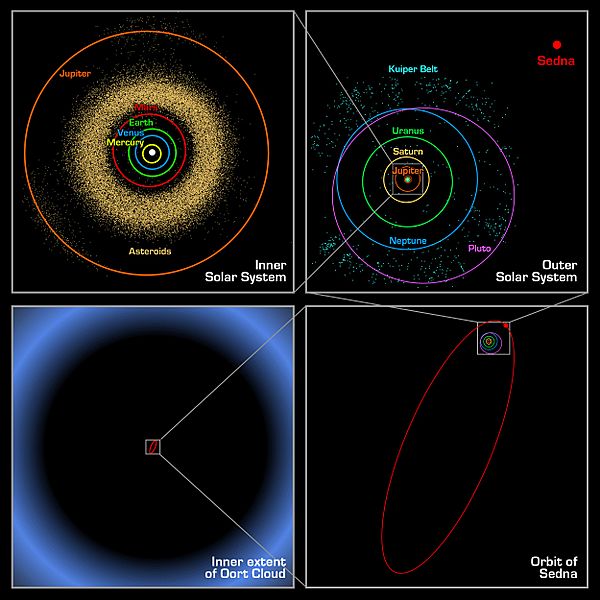Image: Oort cloud Sedna orbit

Description: These four panels show the location of trans-Neptunian object 90377 Sedna, which lies in the farthest reaches of the Solar system. Each panel, moving clockwise from the upper left, successively zooms out to place Sedna in context. The first panel shows the orbits of the inner planets and Jupiter; and the asteroid belt. In the second panel, Sedna is shown well outside the orbits of Neptune and the Kuiper belt objects. Sedna's full orbit is illustrated in the third panel along with the object's location in 2004, nearing its closest approach to the Sun. The final panel zooms out much farther, showing that even this large elliptical orbit falls inside what was previously thought to be the inner edge of the spherical Oort cloud: a distribution of cold, icy bodies lying at the limits of the Sun's gravitational pull. Sedna's presence suggests that the previously speculated inner disk on the ecliptic does exist.
Title: Oort cloud Sedna orbit
Credit: [1] [2] Splitzer Space Telescope Released Images about Sedna
Author: Image courtesy of NASA / JPL-Caltech / R. Hurt Original text courtesy of NASA / JPL-Caltech
Permission: This file is in the public domain in the United States because it was solely created by NASA. NASA copyright policy states that "NASA material is not protected by copyright unless noted". (See Template:PD-USGov, NASA copyright policy page or JPL Image Use Policy.) Warnings: Use of NASA logos, insignia and emblems is restricted per U.S. law 14 CFR 1221. The NASA website hosts a large number of images from the Soviet/Russian space agency, and other non-American space agencies. These are not necessarily in the public domain. Materials based on Hubble Space Telescope data may be copyrighted if they are not explicitly produced by the STScI.[3] See also Template:PD-Hubble and Template:Cc-Hubble. The SOHO (ESA & NASA) joint project implies that all materials created by its probe are copyrighted and require permission for commercial non-educational use. [4] Images featured on the Astronomy Picture of the Day (APOD) web site may be copyrighted. [5] The National Space Science Data Center (NSSDC) site has been known to host copyrighted content even though its photo gallery FAQ states that all of the images in the photo gallery are in the public domain.
Usage Terms: Public domain
License: Public domain
Attribution Required?: No
Image usage
The following page links to this image:

